A Fascinating New Higgs Boson Search By
The DZERO Experiment
By Tommaso
Dorigo

Reporting on scientific results to a broad audience is
difficult, in my opinion, not so much because of the need to
explain things in a simple way -which is easy and fun, once you
master the matter- as for the self-discipline you are forced to
stick to.
Things that are obvious to you, because you have seen them and
studied them for years, are not obvious to others, not even to
fellow scientist from the other door who practice a just
slightly different sub-field of research, let alone to the
larger pool of smart readers who are drawn to science readings
but have never taken an advanced course on the matter. An alarm
bell has to go off every time you hit on a concept which is
likely unfamiliar to most: maintaining in good operation that
alarm bell is by far the hardest part. At least, that is what my
experience tells me.
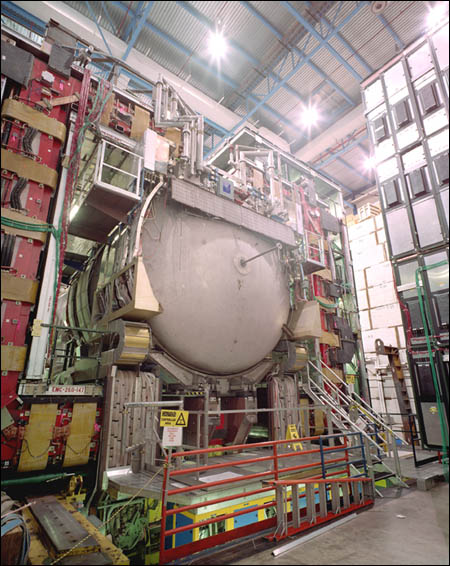
So let me try and check how rusty that alarm bell is today, as I
make an attempt at reporting in hopefully simple terms on a new
particle physics search by the DZERO experiment (see right), one
for a subatomic process that I find extremely interesting, and
which, once found, will make manifest the hard core of our
theory of electroweak symmetry breaking, a fundamental pillar of
our current understanding of the subnuclear world. This process
is the associated production in hadron collisions of three of
the fanciest building blocks that Nature (the bitch, not the
magazine) has provided our playground with: a top-antitop quark
pair, and a Higgs boson.
This, by the way, is a good point for you to jump ahead by a
couple of sections in this long post, if you are curious about
the new DZERO result but know about, or are not interested in,
some underlying basic facts about hadron collisions.
Some background on hadronic collisions
In the case of the result I report today the hadron collider at
hand is not the LHC, the fast-asleep giant sitting underground
below the border between Switzerland and France, but rather the
quite awake Tevatron collider of Batavia, Illinois, which is
traversed daily by a few micrograms worth of protons and
antiprotons, all rigorously traveling at 99.9 and something
percent of the speed of light.
As protons and antiprotons hit each other at that fantastic
speed, they often just bounce off each other retaining their
integrity: physicists call that process "elastic scattering",
but they are not interested in it, because it tells them about
as much on the inner structure of matter as a glance at a glass
of wine can tell you about its tannins.
In closer encounters the protons may break apart, but still
nothing much happens. It is only in those rarer instances when
one of the most energetic quarks or gluons making up a proton
hit directly one of their kin from the antiproton that things
become interesting. The collision is then hard enough that the
two constituents -we call them "partons"- kick each other off
their envelopes, the parent proton and antiproton: they then
materialize in the form of streams of subatomic particles,
energetic sprays that we call hadronic
jets; in still rarer instances, their interaction instead
gives rise directly to new states of matter.
(I have explained elsewhere why quarks
can only be seen as jets, and I will avoid repeating myself
here. Suffices to say that quarks cannot exist isolated, and
they must "dress up" in the form of hadrons. Hadrons are
composed of pairs or triplets of quarks: it is them, and not
individually their constituent quarks, the particles that make
up the jets we observe in energetic collisions.)
Doing business with a hadron collider -a proton-antiproton
collider like the Tevatron, for instance- is a frustrating
experience: you spend your money and wits to build a machine
that accelerates those particles at incredibly high energies,
and then as you turn it on would like to see that energy
materialize into fantastically energetic jets, or even better,
new exotic, massive particles that can only be produced by
exchanging the projectiles' kinetic energy into mass. Instead,
you have to accept the fact that most of the collisions you get
release way less energy than the total theoretically available.
That is because what is colliding are not really the proton and
antiproton that you launched one against the other -or more
precisely, one each among a trillion of the former and a hundred
billion of the latter. What really collides is a (anti)quark or
a gluon inside one projectile and a (anti)quark or a gluon
inside the other. And, since these constituents of the proton
only carry a small fraction of the total kinetic energy of their
parent "envelope", the total energy release is smaller than the
sum of proton and antiproton kinetic energy.
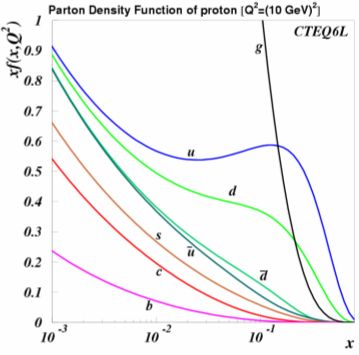
Particle physicists learn this fact in their playground years. Parton
Distribution Functions(PDF) have been devised to describe
what is the probability that a quark or a gluon is found with a
given fraction of their envelope's total energy. The graph on
the left shows their density as a function of the fraction x the
partons carry, for different parton species: g labels gluons, u
are up-type quarks, d are down-type quarks, etcetera. Needless
to say, these functions get vanishingly small as the fraction
approaches unity: at the Tevatron for instance you will never,
ever, get a collision releasing 1.96 TeV, which is the sum of
the proton and antiproton energies provided by the
superconducting, 4-mile-long accelerator. The same, of course,
goes for the LHC: 14 TeV will never be actually reached by that
machine; nope: not even if its currently ongoing repairs exceed
expectations!
How energetic can a collision be at the Tevatron, then ? That
depends: the larger the number of collisions you observe, the
higher is the chance to see a very energetic one. The most
energetic collisions recorded by CDF and DZERO, the two
experiments built around the points where the Tevatron proton
and antiproton beams intersect, have a total energy release of
about 1 TeV, but they are exceedingly rare. Below is a 2-D bar
chart of the energy read out by the DZERO detector for two
high-energy jets: the detector is like a cylinder surrounding
the collision point, and it has been cut along one side and
unrolled on the plane you see, to display the localized energy
deposits of the streams of hadrons which hit it. Such events are
spectacular: they are as close as you can get to actually
"seeing" two quarks.
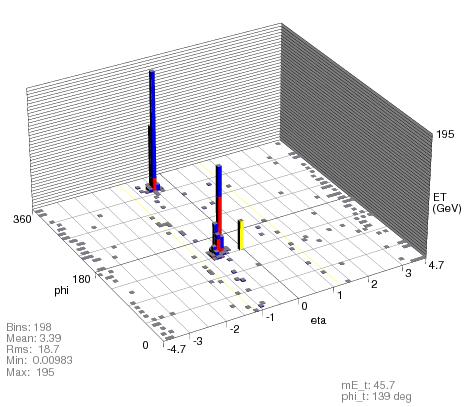
Enter the production process
Now, the above introduction served one important purpose besides
sorting out the few of you who really want to get personal with
elementary particles: it provides important input to figure out
why the production of a top-antitop quark pair AND a Higgs boson
is so rare and special. It is only a part of the whole story,
but let me use the acquired knowledge at once. Top quarks are
the heaviest ones in the lot of six we have figured out matter
can be made of. They weigh about 173 GeV each, which is the
total weight of about 184 hydrogen atoms! As for the Higgs
boson, we may assume it weighs 120 GeV here for the sake of
argument: existing experimental hints point to a
value not too far from the one above.
Let us make a simple addition: two top quarks, plus a Higgs
boson, already make a rest mass of 470 GeV. This is about a
quarter of the total kinetic energy of a proton-antiproton pair
at the Tevatron, and it is an energy which is only reached once
in a million collisions or so. Those PDF are indeed functions
steeply peaking when the fractional energy is close to zero, as
I noted above.
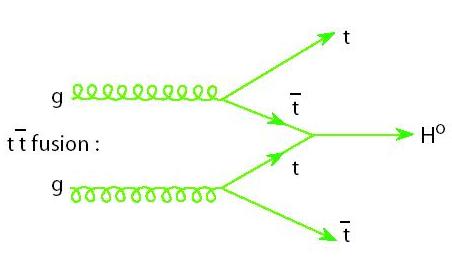
There is at least another important thing to consider. Not all
collisions above 470 GeV produce a top, an antitop, and a Higgs
boson! Quite on the contrary, that piece of magic is a rare
occurrence regardless of the energy release. The rules for
computing the probability of subatomic production processes like
the one we are discussing are enshrined in Feynman diagrams,
graphs which describe the space-time propagation of the
colliding and produced particles. On the left you can see one
such diagram: time is taken to flow from left to right here, and
only one space dimension is drawn, on the vertical axis.
As you see, the way a  reaction
occurs works by first producing a top-antitop pair, and then
letting the duo (in the case shown) "radiate off" a Higgs
particle. Such a feat is predicted to occur because the Higgs
boson couples to
any particle if the latter possesses a mass, and that is for
sure something that top quarks are good at -they are the
heaviest elementary bodies known to us. Just as a photon can be
emitted by any electrically charged body, and it does so more
readily if the charge of the latter is higher, a Higgs boson
will happily be emitted by any mass-endowed particle. The
difference, however, is that Higgs bosons are very heavy
themselves, and you cannot produce mass out of nothing: the top
quark originating the Higgs boson has better be very energetic
to enable Higgs radiation.
reaction
occurs works by first producing a top-antitop pair, and then
letting the duo (in the case shown) "radiate off" a Higgs
particle. Such a feat is predicted to occur because the Higgs
boson couples to
any particle if the latter possesses a mass, and that is for
sure something that top quarks are good at -they are the
heaviest elementary bodies known to us. Just as a photon can be
emitted by any electrically charged body, and it does so more
readily if the charge of the latter is higher, a Higgs boson
will happily be emitted by any mass-endowed particle. The
difference, however, is that Higgs bosons are very heavy
themselves, and you cannot produce mass out of nothing: the top
quark originating the Higgs boson has better be very energetic
to enable Higgs radiation.
Computing precisely the rate of tth production is beyond my
decidedly experimental expertise, but from the few hints I
provided above you can probably accept that such rate is
seriously dampened by asking for a very specific way of spending
the 500 or more GeV of energy we have already dearly paid for
(a one-in-a-million chance, give or take a cow or two). The
easiest way to release that energy for a proton-antiproton
collision would be to produce two 250-GeV jets like the ones
pictured above: any quark pair would do, and even a pair of
gluons would be a very probable solution. Asking for top quarks
makes this much less probable because most of the energy has to
go into the mass of the two fat guys; and asking that one top
quark spits out a Higgs boson makes this a real rarity.
(If you need more detail, here is an important piece: the
dampening in part comes from the narrowness of a thing called phase
space. Given a fixed 500 GeV energy budget to materialize a
pair of quarks, Nature way prefers light-mass ones, since almost
all the initial energy may then be allocated to endowing quarks
with large momenta, and large momenta translate in a larger span
of allowed configurations. The more configurations, the more
probable a process is! But in our case it is still worse: we
need one of the top quarks to be produced with a mass much
larger than its nominal 173 GeV, since we need the surplus to
materialize the Higgs boson via radiation. Short-lived particles
can indeed be created off-mass-shell,
but the probability for this to happen rapidly decreases with
the departure from their rest mass.)
From the above discussion you have certainly gathered that there
are several factors making tth production a very rare process.
Well, that is exactly true. And here is the final result: all in
all, at the Tevatron one expects less than one in ten trillion
collisions to give rise to a ttH final state.
Once-in-ten-trillions is roughly as frequent as a total failure
of the "save a parent" strategy some dads and moms adopt when
they have to travel, taking different flights to reach the same
destination: once in ten trillion times, both planes crash (I am
purposedly neglecting correlated catastrophes such as 9/11 here,
but you get the point). That is what I call pretty darn rare,
what do you think ?
...And they still search for those!
Despite the rarity of associated production of a top-antitop
pair and a Higgs boson -or maybe because of that!-, the CDF and
DZERO experiments at the Tevatron have started to look for it.
That does not mean the physicists in these collaborations are
desperate: a search for a new physical process predicted by your
theory is intrinsically interesting and worth pursuing even if
you predict your experimental setting cannot reach the required
sensitivity to observe the process, because of a couple of
facts.
One: particle theory -the so-called Standard
Model- has reached a high level of refinement, but putting
it to the test in new ways, such as searching for a process that
is predicted to be unobservable in a particular environment,
might eventually spot an otherwise unnoticed breach in the
theory, opening the way to the unknown. Two: by studying
peculiar and rare final states of particle collisions one might
stumble in some unexpected, unpredicted new process, again
resulting in a disclosure of new physics.
Also, please consider: measuring something which is predicted to
be very small or even better, exactly zero (or undiscernible
from zero) is a very effective way to probe your theory, much
better than checking whether physical quantity A is equal to
seven hundred gudungoons or seven hundred and twelve gudungoons.
The reason for this is that zero is a quite peculiar number: any
departure from zero sticks out as a lamppost, while a
departure from a non-zero quantity can at most be as significant
as the prediction is precise. Or if you prefer, a rare unknown
effect may only be seen by checking if zero is exactly zero,
rather than if some non-zero quantity is in the high-gudungoons
range or not.
In any case, there one last input I have so far denied you: the
number of collisions that have been produced since 2002 in the
core of CDF and DZERO amounts to about 400 trillions each! If
the Higgs boson exists, a handful of those events have most
certainly been popping up: maybe once a year, but they must
have! Now, go tell the needle hiding in the haystack that DZERO
searches for a few events in 400 trillions, and you'll see it
rolling away in laughter. But physicists are clever! So let me
tell you how clever they have been now.
The DZERO search
DZERO searched for the  process
in 2.1 inverse
femtobarns of
collisions, which is little less than a third of what they have
accumulated this far. This delay is due to the gigantic amount
of computing required to reconstruct and analyze the
information, as much as to the complexity of the analyses, which
must at some point "freeze" the datasets they use before
performing further steps which may take months to complete.
Inverse femtobarns sound like complicated things the first time
you hear about them, but they actually simply count the number
of projectiles that have crossed a unit area in the center of
the detector. Multiply that by the "effective area" of their
targets, and you get the number of hits.
process
in 2.1 inverse
femtobarns of
collisions, which is little less than a third of what they have
accumulated this far. This delay is due to the gigantic amount
of computing required to reconstruct and analyze the
information, as much as to the complexity of the analyses, which
must at some point "freeze" the datasets they use before
performing further steps which may take months to complete.
Inverse femtobarns sound like complicated things the first time
you hear about them, but they actually simply count the number
of projectiles that have crossed a unit area in the center of
the detector. Multiply that by the "effective area" of their
targets, and you get the number of hits.
The first step of the analysis consisted in figuring out the
best way to get rid of most the large number of collision events
stored by the data aquisition system, those which were the least
likely to have originated by the production of the ephemeral
trio of heavy particles and their subsequent disintegration into
stable particles -those actually producing the observable
detector signals which constitute the "event" data.
Here I have to unveil a detail I so far hid: the data stored by
DZERO amount to much fewer than hundreds of trillion events,
because the rate at which collisions occur in the core of the
detector during data taking is about three megahertz -three
millions per second-, which is way too high to allow detector
readout and storage. A online trigger system in fact takes care
to neglect those collisions which resulted in elastic scattering
or low-energy release, and only read out and store the most
interesting, energetic events. The trigger system is one of the
most complicated parts of the detector hardware, but I will not
discuss it further here: suffices to say that the offline
analysis starts with a dataset of only billions of events, ones
containing an already pre-selected signal of high-energy
electrons or muons.
Electrons and muons. These are the diamonds collider experiments
mine for. Their presence immediately signals that the original
hadrons gave rise to an electroweak interaction, as opposed to
the much more frequent strong interactions that quarks (and
gluons) are most likely entertain themselves with. A high-energy
electron or muon can only be produced by the decay of a W or Z
boson or by a photon, the carriers of the electroweak
interaction. In our case, these particles signal the decay of
top quarks, and DZERO uses their presence to select a sample of
top quark pair decays.
The decay chain of a top quark pair yielding one electron and
jets can be written as follows: .
Here you see that one of the W bosons produced an
electron-neutrino pair, while the other yielded one further
quark-antiquark pair. Each of the quarks (both the bottom quarks
duo and the generic ones labeled by the letter q) produces a
energetic jet of hadrons, and the top-antitop signature one ends
up observing in the detector is called "single lepton", to
distinguish it from "all hadronic" and "dilepton" ones
containing respectively only jets or two leptons and two jets.
As for the neutrino accompanying each lepton in the W boson
decay, they leave the detector unseen, but their presence is
inferred by the imbalance in the energy flowing out of the
collision point.
.
Here you see that one of the W bosons produced an
electron-neutrino pair, while the other yielded one further
quark-antiquark pair. Each of the quarks (both the bottom quarks
duo and the generic ones labeled by the letter q) produces a
energetic jet of hadrons, and the top-antitop signature one ends
up observing in the detector is called "single lepton", to
distinguish it from "all hadronic" and "dilepton" ones
containing respectively only jets or two leptons and two jets.
As for the neutrino accompanying each lepton in the W boson
decay, they leave the detector unseen, but their presence is
inferred by the imbalance in the energy flowing out of the
collision point.
My DZERO colleagues know extremely well how to best select
top-antitop events in the single lepton final state: they have
been doing this since CDF showed the way, in the days prior to
the top quark discovery in 1995. But in the case at hand, a
Higgs boson must be present in the event: this particle, if it
is not too heavy, decays most of the time into an additional
pair of b-quark jets. The total signature DZERO is after is thus
one of lepton plus many jets, nominally six of them. Since,
however, jets may be lost in uninstrumented regions of the solid
angle around the collision point, or overlap to other jets, or
fail to have enough energy to provide a clear identification,
DZERO chooses to concentrate on two different signatures: lepton
plus four jets, and lepton
plus five or more jets.
After selecting the above topologies, the data is still polluted
with processes that have little to do with top quark pair
production (not to mention the exceedingly rare tth events). A
further cleanup is provided by requiring that at least one of
the jets contains an indication of having been originated by a
bottom quark. Bottom quarks are not as heavy as top quarks, and
thus are not as rare; but they are still rare
enough that their
presence is a strong indication of a top decay.
In the end, DZERO applies a technique we might call "Divide
et Impera" (divide and rule): by slicing and dicing the
selected event set into different classes (each consisting in a
well-defined event signature) a small signal is easier to find,
even if some classes will contain a much smaller fraction of it
than others. Below is a table from the preliminary
paper produced by
DZERO: as you can see, electron plus jets and muon plus jets are
separated, and then events with only 4, or 5+ jets, are kept
distinct. Further, the number of b-quark jets identified in the
event (dubbed "b-tags") allows to define a total of 12 exclusive
subsets. To decode them, take "5j2t" as an example: that class
contains events with at least 5 jets (5j), and exactly two
b-tags found in them (2t).
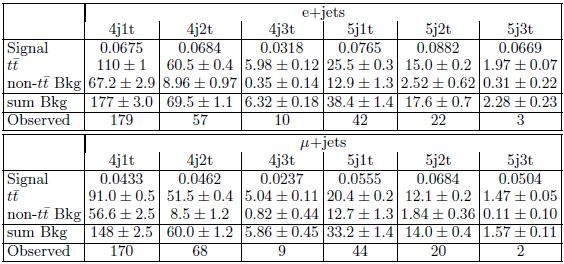
In the table, top-antitop events are estimated separately from
"non-tt backgrounds", to highlight the power of the DZERO
selection: especially in the 2- and 3-b-tags classes, the top
contribution far exceeds the other annoying processes that
pollute the selected dataset. Also, the observed event counts
(shown in the last line for both electron+jet and muon+jet
topologies) match pleasingly the expected sum of backgrounds,
indicating that there are no surprises and possibly no mistakes.
Finally, please notice how the number of events has been reduced
by orders of magnitude by the combination of requirements on the
presence of a lepton and many jets. Still, the expected signal
across the table sums up to less than one event. One event in
626 ? That is not a needle in the haystack anymore! Kudos to
DZERO for their clever selection then!
The final step of the analysis is different from what has become
common practice in the searches of small signals buried in large
backgrounds nowadays. Rather than relying on the modeling of
many observed characteristics of the quite complicated
kinematics these multi-object final states possess, DZERO uses a
single, dumb but foulproof variable: the HT, which is computed
as the sum of transverse energies of all the jets, the lepton,
and the inferred neutrino. This quantity provides a quite
model-independent tool to discriminate tth from tt events, and
its use sidesteps a theoretically nagging problem: our
insufficient understanding of the main background to the search,
the production of top-antitop quark pairs accompanied by
bottom-antibottom pairs.
In the figure below, a HT distribution is shown for the sum of
the two classes most "signal-rich": the ones corresponding to
five or more jets and three or more b-tags. The black points
show the observed data events (a total of five entries), and the
red distribution shows the expectation from known processes
(basically dominated by top-antitop production). The black
histogram instead shows the expected HT distribution that the
signal would display, if it had a production rate exceeding by
100 times the predictions from theory. The different shape of
red and black histogram is the whole point of using HT as a
discriminating variable.
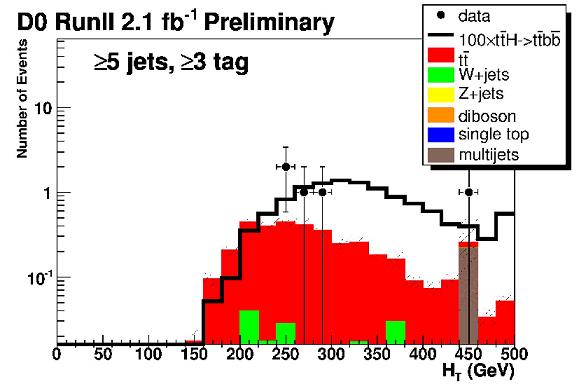
The 12 HT distributions are finally tested by comparing data to
the expectation from the sum of backgrounds (which includes both
top production and non-top processes). A complex, very accurate
method is used to combine the variegated information coming from
the twelve distributions into a single response -the ratio
between the probability that the data contain both signal and
background together, divided by the probability that they
contain only backgrounds. The study of that quantity allows to
set a upper limit on the number of signal events contained in
the data, which can then be converted in a limit on the signal
cross-section by suitably multiplying for the signal detection
and reconstruction efficiency, numbers that can be estimated by
Monte Carlo simulation programs.
The whole procedure is repeated for different hypotheses of the
unknown value of the Higgs boson mass, and the limit thus
becomes a function of it. The end result is displayed, as has
become customary, as a curve showing, as a function of the Higgs
mass, the ratio between the resulting upper limit on signal
cross section and the cross section that is predicted by the
Standard Model theory. That is to say, if for a given
hypothetical Higgs mass a limit is set at a value equal 100,
that means that DZERO's data exclude the presence of tth
production at a rate exceeding 100 times the predicted
production rate, in case the Higgs has that mass.
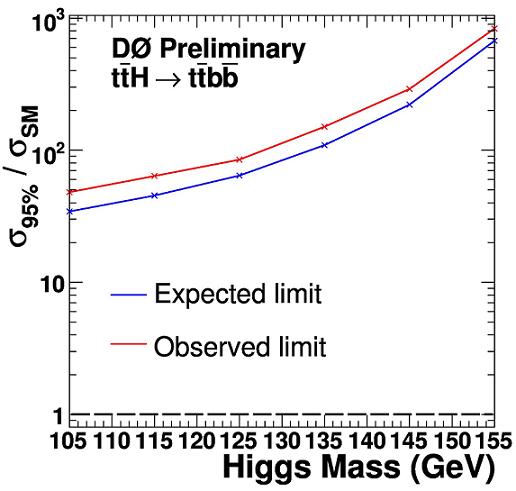
As you can check in the graph on the right, the limit is not
very stringent! In fact, an exclusion of a mass range for the
Higgs boson would result if the limit curve assumed values below
1.0 in that range (the hatched black line). Instead, the red
curve (labeled Observed
limit) is floating at values well above 30 times the
Standard Model prediction. This should not be read to imply that
the DZERO search has not been fruitful or successful! The result
is, in fact, quite interesting, for several reasons.
First of all, an anomalous coupling of the Higgs boson to the
top quark might boost the production rate above Standard Model
predictions, and the DZERO limit sets a bound on that
occurrence. Second, the final states investigated by the search
had never before studied in detail at the Tevatron, and it feels
good to see we do understand the production of top quarks in
association with b-quarks. Third, the search provides guidance
for future investigations in the same direction. Fourth, the
limit, although very loose, can be combined with advanced
statistical procedures with the much more stringent ones coming
from higher-rate production processes of the Higgs boson,
eventually contributing to advancing our knowledge of that
elusive particle. Elusive is certainly an appropriate word:
Higgs bosons have been hypothesized more than forty years ago,
and we still have to see one of them...
The only remaining taks, at the end of this long article, is for
me to ask you, dear readers, whether the alarm bell I mentioned
at the beginning needs to be serviced!
Further reading:
A call for ideas on how to improve a prospective search for tth
events with the CMS detector
Home page of the DZERO experiment
Home page of the Fermi National Accelerator Laboratory
Real-time display of Tevatron performances







